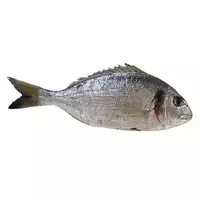Zuban fish

Marine toothfish mainly live in the Indian, Atlantic and Pacific oceans, but it is not uncommon to find them in the eastern Atlantic and the Black Sea (from Mauritania to the British Isles). It is noteworthy that it got its name directly for its appearance, namely for teeth in the form of fangs. There are several species of toothfish in nature: for example, lobaceous, canary small, canary large and many others. Depending on the specific subspecies, the mass of this large fish can reach 4 kilograms with a body length of up to 80 centimeters. However, individual individuals can "boast" and meter length with a weight of 14 kilograms, but this is more an exception than a pattern.
The appearance of toothfish is typical of sea carp, in which the body is rather flat from the sides. Unlike young individuals with a brown color with bluish fins, adult representatives of this species have a grayish-blue color. Living at a depth of up to 200 meters, the toothfish is an active predator, whose diet includes small fish, as well as common and cephalopods.
From a gastronomic point of view, snow-white fish meat is highly appreciated by seafood lovers, as it is distinguished not only by delicate juiciness and excellent taste, but also by versatility - it is suitable for any type of culinary processing. Resembling the meat of sea bass to taste, toothfish refers to table fish and is used to prepare a variety of dishes. Due to the fact that it contains few bones, minced meat for cutlets, meatballs, as well as pie fillings are often made from the meat of this fish. It is served either fried or boiled or stewed.
fish tooth 131.9 kCal
Energy value of zuban fish (Ratio of proteins, fats, carbohydrates - ju):
Proteins: 18.8 g (~ 75 kCal)
Fats: 6.3 g (~ 57 kCal)
Carbohydrates: 0 g (~ 0 kCal)
Energy ratio (b | y): 57% | 43% | 0%
 Español
Español Français
Français Português
Português Русский
Русский 简体中文
简体中文 繁體中文
繁體中文 日本語
日本語 한국어
한국어 العربية
العربية Türkçe
Türkçe Қазақ
Қазақ Deutsch
Deutsch Italiano
Italiano Українська
Українська
